The Intel Skylake Mobile and Desktop Launch, with Architecture Analysis
by Ian Cutress on September 1, 2015 11:05 PM ESTThe Claims
As with any launch, there are numbers abound from Intel to explain how the performance and experience of Skylake is better than previous designs as well as the competition.
As with Haswell and Broadwell, Intel is implementing a mobile first design with Skylake. As with any processor development structure the primal idea is to focus on one power point as being the most efficient and extend that efficiency window as far in either direction as possible. During IDF, Intel stated that having an efficiency window from 4.5W to 91W is a significant challenge, to which we agree, as well as improving both performance and power consumption over Broadwell at each stage.
Starting at 4.5W, we spoke extensively with parts of Intel at IDF due to our Broadwell-Y coverage. From their perspective Broadwell-Y designs were almost too wide ranging, especially for what is Intel’s premium low-power high performance product, and for the vendors placing it in an ill-defined chassis far away from Intel’s recommended designs gave concern to the final performance and user experience. As a result, Intel’s guidelines to OEMs this generation are tightened so that the designers looking for the cheaper Core M plastic implementations can tune their design to get the best out of it. Intel has been working with a few of these (both entry Core M and premium models) to enact the user experience model.
Overall however, Intel is claiming 40% better graphics performance for Core M with the new Generation 9 (Gen9) implementation, along with battery saving and compatibility with new features such as RealSense. Because Core-M will find its way into products from tablets to 2-in-1s and clamshells, we’ve been told that the Skylake design should hit a home-run against the best-selling tablets in the market, along with an appropriate Windows 10 experience. When we get units in to review, we will see what the score is from our perspective on that one.
For the Skylake-Y to Skylake-U transition (and in part, Skylake-H), Intel is claiming a 60% gain in efficiency over Haswell-U. This means either 60% less active power during media consumption or 60% more CPU performance at the same power (measured by synthetics, specifically SPECint_base_rate2006). The power consumption metrics comes from updates relating to the Gen9 graphics, such as multi-plane overlay and fixed-function decoders, as well as additional power/frequency gating between the unslice and slices. We will cover this later in the review. The GPU itself, due to the new functionality, is claiming 40% better graphics performance for Core M during 3DMark synthetic tests.
While not being launched today, Intel’s march on integrated graphics is also going to continue. With the previous eDRAM parts, Intel took the crown for absolute IGP performance from AMD, albeit being in a completely different price band. With Skylake, the introduction of a 4+4e model means that Intel’s modular graphics design will now extend from GT1 to GT4, where GT4e has 72 execution units with 128MB of eDRAM in tow. This leads to the claim that GT4e is set to match/beat a significant proportion of the graphics market today.
Back in our Skylake-K review, we were perhaps unimpressed with the generational gain in clock-for-clock performance, although improved multi-threading and frequency ranges helped push the out-of-the-box experience. The other side of that performance is the power draw, and because Skylake is another mobile-first processor, the power aspect becomes important down in mobile devices. We will go through some of these developments to improve power consumption in this article.


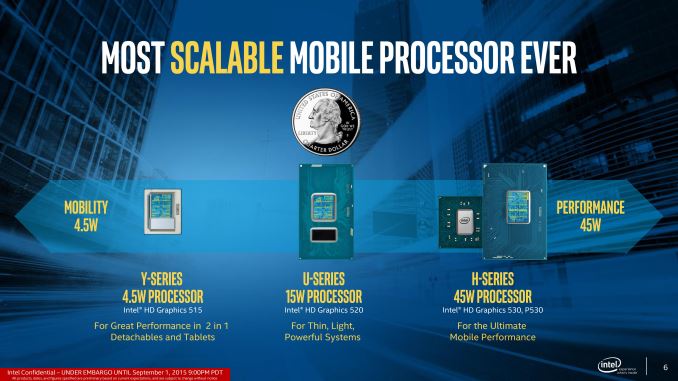
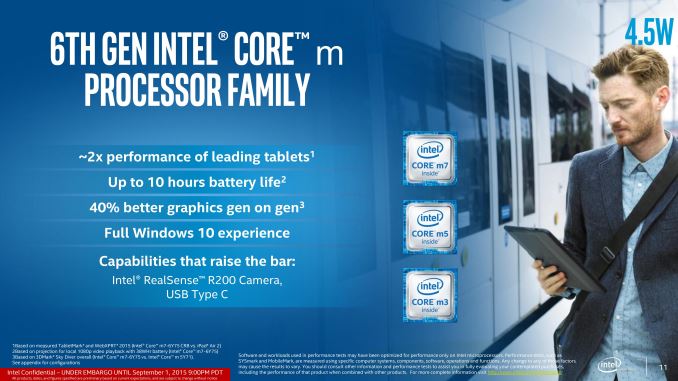
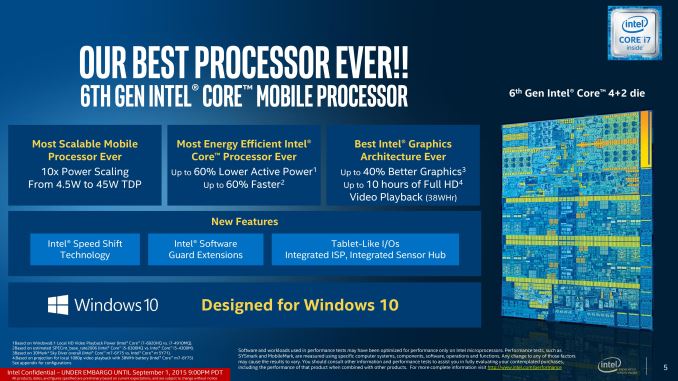
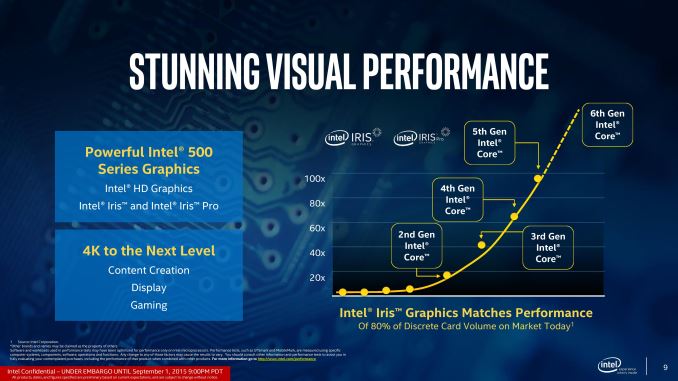
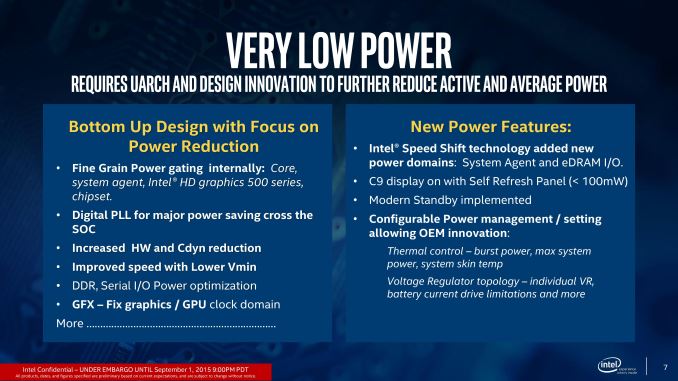








173 Comments
View All Comments
extide - Saturday, September 5, 2015 - link
No it's a euphemism for better TIM.MrSpadge - Wednesday, September 2, 2015 - link
Any word on AVX-512, especially on those mobile Xeons? The same question applies to Xeons for the desktop socket. I suspect they'll simply be the same die, so if they have it Intel would be deactivating it for all regular CPUs. The other option would be: not all Xeons have, and the big dies actually have modified cores (as Intel hinted at IDF, without giving any details).nils_ - Thursday, September 3, 2015 - link
I'd also like to see SHA256 as a CPU instruction, and not even for bitcoin mining.zepi - Wednesday, September 2, 2015 - link
It is in a way curious, that Intel is releasing 35W TDP socketed desktop-chip when the lowest they'll do for mobile is 45W.zepi - Wednesday, September 2, 2015 - link
Oh, and in the conclusions page you are mentioning 4+3 parts. From the article I understood there are only going to be 4+4 (128MB) parts and 2+3 (64MB) parts.Later are available as both 15 and 28W parts, though it is quite possible that the GPU performance takes quite a hit with the lower TDP. I hope you'll get to do comparisons between different GPU SKU's.
watzupken - Wednesday, September 2, 2015 - link
I have my doubts about how well the 72 EU graphic will bring about significant performance improvements. Looking at the trend of integrated graphics by Intel over the last 2 gen, between a 24 and 48 EU solution, the improvements are marginal in most cases. I believe its limited by 2 things, memory bandwidth, and most importantly, the amount of power it can draw. Memory bandwidth can be rectified with the e-DRAM, but still its limited by power. I feel the difference between Skylake and Broadwell graphics is negligible if we compare the same class of processor.xenol - Wednesday, September 2, 2015 - link
I'm failing to see how transistor counts and die size mean anything to anyone else. "Hey guys, Intel has 2 billion transistors in their CPU, we should make ours have 2 billion and 1! That'll show them!"V900 - Wednesday, September 2, 2015 - link
Economics, my friend, economics...If you know a little bit about their manufacturing/fabs (FINFets, double, triple or quadruple patterning?) plus how many transistors they have in their CPU. And you know the exact W*L and total area in square mm, then it's fairly trivial to come up with some pretty good guesses about their financial model.
How many CPUs can they make in a 300mm wafer in a day? How many of a given batch do they need to throw out, and how many can they repurpose towards lower priced parts? In other words, what is Intels real cost for manufacturing a given part, and how cheap can they sell it and still make a profit?
xenol - Wednesday, September 2, 2015 - link
Part of me still doesn't believe that info should be locked away (and Anand already found the die size so you can get a good enough estimate with that and previous numbers).At the end of the day, the only thing the consumer cares about is how fast it performs. The other numbers are just for pissing contests.
wintermute000 - Wednesday, September 2, 2015 - link
pretty sure power consumption also matters, at least in mobile